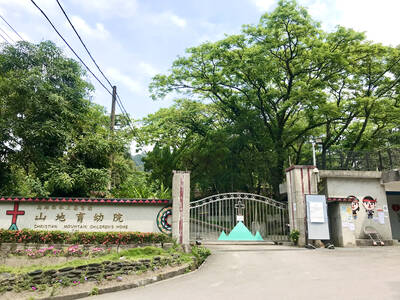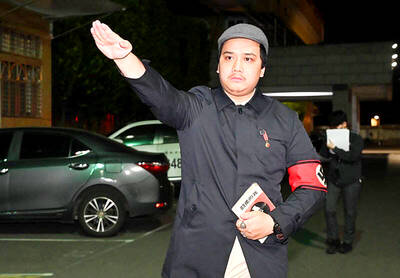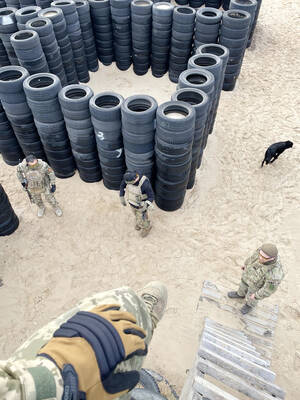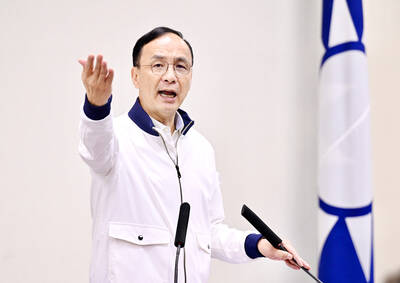Once tattooing was just for outsiders, the pian yuan jen (
He has seen singers and models, even businessmen and civil servants, show them off without fear of stigma -- a sign that tattooing is slowly becoming a mainstream fashion trend in Taiwan. "Like custard tarts and Hello Kitty, tattoos are now in," says Damau, one of a growing group of respected tattooists and body painters now operating in Hsimenting, Taipei, where Japanese fashion copycats or Harizu (
Hsimenting has become a locus for body painting and a new esthetic for tattoos is steadily growing, which fuses Western, traditional Chinese and Japanese designs. Nourished by colorful images served up by the media and dreams of being like Shaq or Cher, or pop stars like Shino (

Damau, 32, is the man who will do it. At present, though, he's making some of his customers wait. He's too busy carving a dragon into a young man's right arm, talking on two phones, doing this interview, asking a TV crew to wait outside and taking snapshots of his work. Everything is clean, ordered and efficient in his fourth-floor business and Damau talks quickly -- he hasn't got much time; he has another arm to mark for life in 30 minutes.
ART, NOT FASHION
Unlike most tattooists, Damau doesn't use a transfer to trace the design or picture on the skin, before the drill, with its fresh needle full of ink, starts mechanically tearing at the skin. "Tattooing is an art; it's just different materials. I think skin is special," he says as he works. "People come to my shop and ask my opinion about what they want. Then I do the painting, direct on the skin [without transfer], so I don't lose the spirituality of the drawing. A tattoo is a living thing."
Damau, who started his shop eight years ago, does illustrations for textbooks and magazines, but he won't do fashion shows, only news programs. "I get a lot of invitations for entertainment shows, but I don't do them because I don't want teenagers to think that tattooing is just a fashion," he says.
Damau is serious about his work and keen to change perceptions of his trade.
"Gangsters? I only do real gangsters. People with tattoos aren't bad; people who don't have tattoos often are, just look at the politicians and policemen."
Damau may be an artist who claims not to like the fashion business, but the facts are it is paying well. Though tattooing is not mainstream, yet, it is becoming big business. It costs around NT$2,000 for a 7cm design on the arm that takes roughly half an hour. A shoulder will cost NT$10,000 and upward, depending on the design and coloring. A good tattooist can make-over about 20 people a day.
Although there are no official figures, since tattooing is not licensed and because many tattooists are part time and one-man band operations working privately, estimates suggest there may be around 300 working tattooists in Taiwan today. This is up from the five shops that were around five years ago.
So, it's not hard to figure that a good tattooist can make nearly NT$40,000 plus a day and that if the trend continues a good proportion of Taiwan may be tattooed in 10 year's time.
It's not just Taiwan, either, tattooing is a global growth industry, as the mountain of coffee table books and magazines like Skin and Ink, Tattoo Flash and Tattoo Savage confirm. In 20 years the number of tattoo parlors in the US has risen from 300 to 4,000.
ORIENTAL INFLUENCE
Body art has grown in popularity and many Western tattooists have been looking eastward to "oriental" designs for fresh ideas, some 3,000 years old.
Which is one of the reasons Taiwan has become popular for tattooing, tapping the reservoir of traditional Chinese images and fusing designs from around the world, including Celtic bands, technological themes, Chinese characters, even Aboriginal work.
Kevin, a 28-year-old tattooist known only by his first name, has his own shop down a popular alley in the middle of Hsimenting. He advertises: nail painting or crystal nails, cleaning and repairing tattoos, non-permanent tattoos, (European, Japanese, US and army- and jail-style pictures), and neon tattoos -- which glow in ultra violet light.
It is a one-stop body shop. Techno music pumps out from the front office, where girls are having their nails painted, people are standing around, wading through photo albums of "tats" or discussing their requirements, and prices.
Just opposite there is a passageway into a building and a little studio where a tattooist is crouched over a young man, carving a female samurai into his back. First the skin is scarred with the drill and a needle that purrs and hums like a shaver. Then the inks are applied. This is a first step for the client who will pay and leave when the girl's outline is completed and some ointment is put on the finished work, to protect the wound. He will probably come back when the tattoo is healed in three to four weeks time so that her clothes, hair, skin color and whatever else he wants can be inked in.Though Kevin is also suspicious of tattooing being seen as just a fashion, he has embraced its current popularity. Particularly with non-permanent tattooing, which comprises 60 percent of his trade. Many people, understandably, do not want a tattoo for life, so they will have a non-permanent tattoo to check if they want a "real one." Or else they just want to look "interesting" or special for the night.
Many TV and rock stars go to his studio, and he is willing to do fashion, rap and DJ shows, total body painting festivals, advertising and even face painting for children. Ten years from now he can see the day when getting your body painted will be as common as getting a hairdo. This is the long-range business forecast.
Kevin starts tattooing one of three girls who are having the same design etched into their shoulders. They are also there to get help with their graduation show, which features body painting.
The first girl, Chang Chun-chen (張筠晨), says, "I got the tattoo because it looks good and reminds me of the day I broke up with my boyfriend." The second girl, Mulan says, "I just like it, that's why I had it." Chang Chun-wei (張筠薇) says, "We are sisters and doing this shows we are sisters." In fact two of the girls are blood sisters and the third is now an honorary member of the family. So, the tattoos are a symbol of their relationship, an expression of the bond they feel.
Kevin has four tattoos that are visible. Each is done in a different style as a form of advertising. One picture is of his wife and she looks just like the photo. There are two dragons on either arm and a shark. He comes from a traditional "soldiers village" in the country and "wanted a tattoo from an early age. I held that attitude and when I left the army I got one. It's my body and I didn't worry about what my parents thought."
"Traditional society still does not accept tattoos," he says. "If you want to be a policeman they will not accept you and in the army they will make life tough for you." So in the past, Kevin says, 80 percent of tattooists had spent time in jail, but now they are as likely to come from art college or some similar background. There is money to be made and for the great majority tattoos are no longer the mark of the outsider, just an extreme form of body ornamentation.
But Damau says tattoos are about more than just looking good. He has a formula: "Need -- hurt -- remember." If you need a tattoo, then it is going to hurt. And if it hurts, then you will remember why you got it in the first place.

May 18 to May 24 Pastor Yang Hsu’s (楊煦) congregation was shocked upon seeing the land he chose to build his orphanage. It was surrounded by mountains on three sides, and the only way to access it was to cross a river by foot. The soil was poor due to runoff, and large rocks strewn across the plot prevented much from growing. In addition, there was no running water or electricity. But it was all Yang could afford. He and his Indigenous Atayal wife Lin Feng-ying (林鳳英) had already been caring for 24 orphans in their home, and they were in

On May 2, Chinese Nationalist Party (KMT) Chairman Eric Chu (朱立倫), at a meeting in support of Taipei city councilors at party headquarters, compared President William Lai (賴清德) to Hitler. Chu claimed that unlike any other democracy worldwide in history, no other leader was rooting out opposing parties like Lai and the Democratic Progressive Party (DPP). That his statements are wildly inaccurate was not the point. It was a rallying cry, not a history lesson. This was intentional to provoke the international diplomatic community into a response, which was promptly provided. Both the German and Israeli offices issued statements on Facebook

Even by the standards of Ukraine’s International Legion, which comprises volunteers from over 55 countries, Han has an unusual backstory. Born in Taichung, he grew up in Costa Rica — then one of Taiwan’s diplomatic allies — where a relative worked for the embassy. After attending an American international high school in San Jose, Costa Rica’s capital, Han — who prefers to use only his given name for OPSEC (operations security) reasons — moved to the US in his teens. He attended Penn State University before returning to Taiwan to work in the semiconductor industry in Kaohsiung, where he

Australia’s ABC last week published a piece on the recall campaign. The article emphasized the divisions in Taiwanese society and blamed the recall for worsening them. It quotes a supporter of the Taiwan People’s Party (TPP) as saying “I’m 43 years old, born and raised here, and I’ve never seen the country this divided in my entire life.” Apparently, as an adult, she slept through the post-election violence in 2000 and 2004 by the Chinese Nationalist Party (KMT), the veiled coup threats by the military when Chen Shui-bian (陳水扁) became president, the 2006 Red Shirt protests against him ginned up by